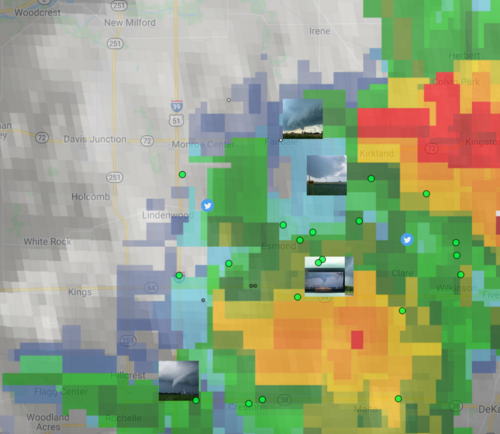ChristofferB
EF2
- Joined
- Aug 27, 2009
- Messages
- 197
I just published a Beta version of a web application I call StormWindow I have created. It is a map based storm chasing overview web application where you can see position of chasers, photos from storms as they develop, tweets from chasers/tweeters as events are happening - all within the time window of the last 24 hours. The idea of the website is to provide an answer to: "What's going on at the moment (and lately) in terms of storm and storm chasing?"
Please have a look here (at this temporary url): StormWindow by StormChasingUSA.com
Today may not be the most exciting day to look at it but yesterday was pretty cool. I am only "launching" it here on StormTrack in order to get some feedback before I proceed further (please refrain from sharing it further at the moment). I would love some feedback!
The spotter position data has been taken from SpotterNetwork.org. Tweets through the Twitter API and other data from SPC. I have just aggregated all the data into one application. My biggest concern, and what I would like to discuss the most is the issue of privacy. As such, I am launching it without some useful features such as the ability to search for a specific chaser, limit the zoom possibilities, and with names of regular spotters hidden behind initials. Chasers who tweet and geo-located tweets are shown in full.
The position data is being reported to SpotterNetwork through apps such as RadarPro, GRLevelX etc. and SpotterNetwork offers an API (and publicly available data) to retrieve those positions, which is really useful when it comes to follow people on a chase. I assume most, if not all, chasers are aware of this as you can see other spotters in those applications. This is all very good, but it seems like quite a lot of spotters forget, or don't care about, turning their position broadcasting off when they are not chasing.
So, I would love some feedback on the web application itself (user interface, functionalities etc) as well as ideas on how to balance the privacy issues with the useful functionalities of it. Any feedback on the legal part of it as well would be much appreciated.
What do you think?
Please have a look here (at this temporary url): StormWindow by StormChasingUSA.com
Today may not be the most exciting day to look at it but yesterday was pretty cool. I am only "launching" it here on StormTrack in order to get some feedback before I proceed further (please refrain from sharing it further at the moment). I would love some feedback!
The spotter position data has been taken from SpotterNetwork.org. Tweets through the Twitter API and other data from SPC. I have just aggregated all the data into one application. My biggest concern, and what I would like to discuss the most is the issue of privacy. As such, I am launching it without some useful features such as the ability to search for a specific chaser, limit the zoom possibilities, and with names of regular spotters hidden behind initials. Chasers who tweet and geo-located tweets are shown in full.
The position data is being reported to SpotterNetwork through apps such as RadarPro, GRLevelX etc. and SpotterNetwork offers an API (and publicly available data) to retrieve those positions, which is really useful when it comes to follow people on a chase. I assume most, if not all, chasers are aware of this as you can see other spotters in those applications. This is all very good, but it seems like quite a lot of spotters forget, or don't care about, turning their position broadcasting off when they are not chasing.
So, I would love some feedback on the web application itself (user interface, functionalities etc) as well as ideas on how to balance the privacy issues with the useful functionalities of it. Any feedback on the legal part of it as well would be much appreciated.
What do you think?

